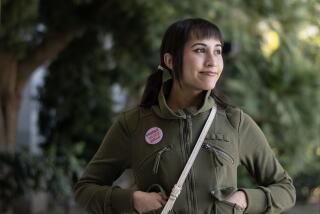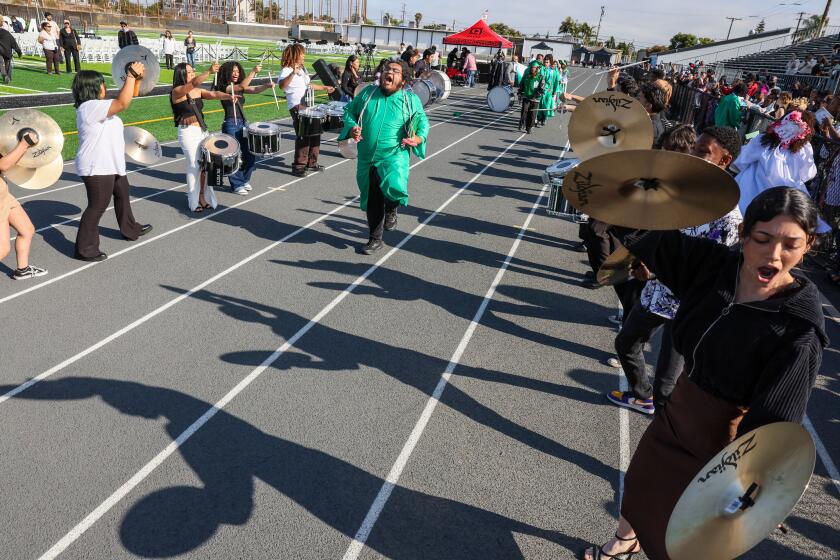CSU Picks Campus Site : Education: A university committee votes for a parcel west of Camarillo as the system’s 21st college. But the decision comes with a warning.
Capping a five-year search for land to build a state university in Ventura County, a committee of Cal State trustees on Tuesday chose a lemon grove between Camarillo and Oxnard as the future home of the system’s 21st campus.
But the 4-1 vote came with a warning: The so-called Duntley/Chaffee site represents Ventura County’s last chance for a four-year public university, California State University trustees and staff said.
If the cost to build on the 320 acres of unincorporated land proves prohibitive, Ventura County will lose its opportunity to host a state university, said Trustee Anthony M. Viti, chairman of the site selection committee. There are no viable alternative sites in the county, he said.
“We’ve expended a lot of effort, time and a lot of money on this site,” Viti said. “If we are frustrated, I don’t see us approaching the county again this century.”
Joyce Kennedy, director of the Ventura campus of Cal State Northridge, said after the meeting that the long-awaited selection of a site leaves her optimistic that a state university will be built in the county.
“But it’s not a done deed. We’ve been in this very room two times before, once for Lusk and once for Taylor,” she said, referring to two proposed Ventura sites that were killed after community opposition developed.
John M. Smart, vice chancellor of university affairs, said the Duntley/Chaffee property, which sits north of the Ventura Freeway at Santa Clara and Central avenues and next to a California Youth Authority prison, will make a successful campus as long as the neighboring communities are committed to a university.
“If the community is not supportive, there is a good possibility that something will drag it down,” Smart said.
Although no organized opposition to the Camarillo property has developed, several homeowners in the exclusive Las Posas Estates east of the site have said they fear that students seeking shortcuts will race through their narrow, winding streets.
“College kids will look for the quickest way to get there, just as I did when I went to UCLA,” said Nancy Stowell, a homeowner on Fairway Drive near the Las Posas Country Club golf course. “It will change the complexion of the community.”
Some pilots have also objected to building the campus at the site, which is beneath the approach path of the Camarillo Airport. The pilots fear that the noise will eventually prompt the university to ask the airport to curtail its activities.
Tuesday’s decision must be ratified by the full board of California State University trustees today, but that vote is expected to be largely a formality.
Cal State proposes to build a two-year campus to serve 2,000 juniors, seniors and graduate students that would develop into a four-year institution in several years and is projected to have 20,000 students.
The Camarillo and Oxnard city councils have endorsed the site, saying they are willing to work with Cal State to deliver the services it needs. Camarillo has had discussions about annexing the site.
In addition, both the Ventura County Board of Supervisors and the Local Agency Formation Commission, the board that must approve all city boundary changes in the county, will support the university, said LAFCO Executive Director Robert Braitman.
“We realize there is a significant amount of work that needs to be done regarding the extension of services to the site,” Braitman told the trustees. “But we are eager to help your staff do those things.”
State Sen. Gary K. Hart (D--Santa Barbara), who sponsored 1985 legislation to set aside $7 million to buy property for a Ventura County campus, also pledged his help in getting funds allocated to build the school.
The property west of Camarillo won the endorsement after extensive studies showed that it had fewer environmental problems than two locations in Ventura and Oxnard. The Ventura site, just east of town, has earthquake faults, and the Oxnard site, south of the city, has hazardous wastes from abandoned oil field operations.
However, the Camarillo land also has problems that must be overcome, including the cost to establish essential services such as water and sewers, its tendency to flood during winter rains and its proximity to the California Youth Authority prison.
The cost of delivering services remains to be determined, officials said. But flooding can be controlled with a channel that has been designed but not funded by the federal government, environmental consultant Brian Boxer said.
The California Youth Authority prison, which abuts the proposed university site to the north, prompted the only dissenting vote on the five-member site-selection committee on Tuesday.
Trustee Marian Bagdasarian objected to putting a campus near the prison, which houses more than 800 young criminals up to age 24.
“Of all the places we could build a university, why do we have to build it next to a CYA facility?” she asked her fellow board members. “I cannot vote for this.”
The youth authority has added surveillance cameras and fences to increase security at the prison and welcomes the university as a neighbor, officials said.
Despite the problems, Viti called the site the best available in the county. Other trustees also praised the site.
“No site is perfect,” said Trustee William Campbell, chairman of the full board. “But this site has everything we need.”
The site must be purchased within the $6-million budget that remains after spending $1 million on an environmental study to evaluate the three sites. David Leveille, university director of institutional affairs, said he believes that the budget will be adequate to buy the property from its owners, Sakioka Farms and Mohseni Ranches.
Ventura County’s long history as a potential host for a public university dates to the 1960s, when studies on higher education named it as a potential site. In 1974, the present off-campus center of Cal State Northridge opened. That campus, which serves 1,200 students, has grown beyond its rented facilities.
Cal State staff began searching in earnest for a Ventura County site in 1985. The Lusk site near the Ventura Harbor was selected, but nearby homeowners objected to the additional traffic a university would bring to Harbor Boulevard.
The university turned its attention to the Taylor Ranch, an ocean-view bluff west of the city of Ventura. But environmentalists and four members of the Ventura City Council feared runaway growth in the county’s west end.
After opposition became more vocal and Taylor Ranch owners refused to negotiate with the university, Cal State backed away from the ranch and reopened the search. Cal State looked at 40 sites in the county before choosing the three to study in depth.
“We hope that any opposition we do have will be manageable,” Viti said. “I believe we have exhausted all other sites in the county.”
More to Read
Sign up for Essential California
The most important California stories and recommendations in your inbox every morning.
You may occasionally receive promotional content from the Los Angeles Times.






